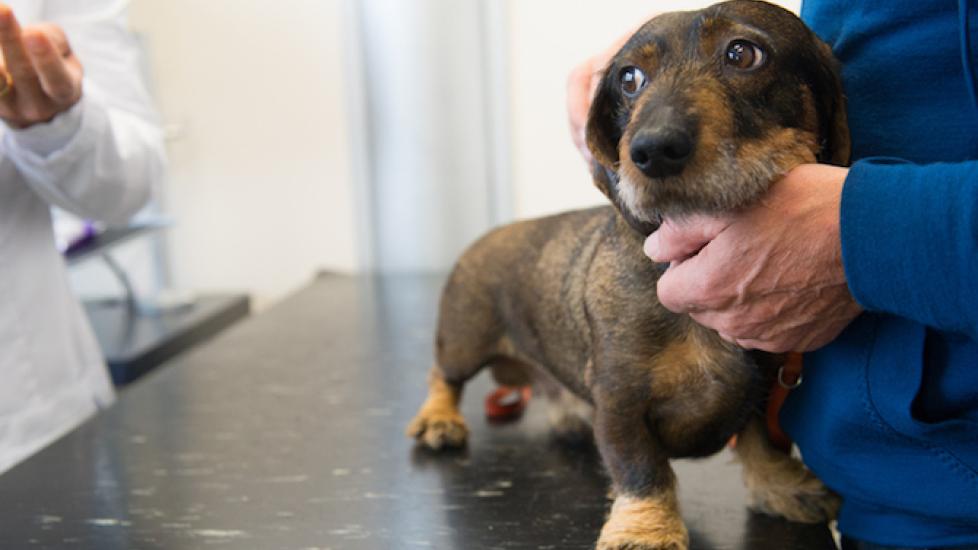How to Desensitize Your Pet to the Vet
By Carol McCarthy
If there is one experience that all pet parents have witnessed or been party to, it is that of a frightened animal having a hard time coping at a veterinary office.
The cause of a pet’s anxiety at the vet is not always clear, but pet parents can take steps to “desensitize” their pet, according to Victoria Schade, a dog trainer, speaker, and author.
Helping your pet stay calm will make vet visits more pleasant—and productive—for all involved.
Causes of Fear and Anxiety During Vet Visits
Fear of the unknown is a big cause of stress for pets during a vet visit, particularly for cats, says Dr. Cathy Lund of City Kitty, a feline-only veterinary practice in Providence, Rhode Island. “Cats are the ultimate control freaks of the animal kingdom. They want everything familiar,” she says. “The cat carrier, the car, the different smells at the office—these all stress them out.”
The nature of vet visits can also stress out your pet, Schade says. “An exam can be uncomfortable. It’s a unique way of being handled. Plus, it’s not something that happens frequently, so it is going to be met with a little trepidation.”
Unfortunately, neither your pet’s breed nor home environment can predict which animal will be anxious, Schade explains. “Within a household, you can have one dog who is relaxed and one who is a challenge, even with the exact same circumstances.”
Another factor that can cause anxiety is the memory of a negative experience. Science has shown that people have a “negativity bias”—that is, we remember unpleasant events more vividly than pleasant ones. “Therefore, animals who have been traumatized by an experience at the vet are more likely to react badly at future visits,” Schade says.
Know When Your Pet Is Stressed
When cats are stressed, they will hiss, growl, flatten themselves out, or try to scratch or bite, Lund says. “It’s defensive behavior—cat language for, ‘Back off, sucker.’”
Dogs, on the other hand, can exhibit a variety of behaviors. “Some shut down, shrinking away, with ears and head down,” Schade describes. “Others snarl, bite, or try to get away in really dramatic displays of fearfulness.”
Get Your Pet Used to Handling
Schade and Lund both agree that making your animal comfortable requires time, patience, and a little bit of homework.
Start by getting your pet used to body handling at home. Clean their ears, clip their nails, brush their teeth, touch them near the tail or stomach. That way, the vet’s exam won’t feel completely foreign.
You can also leave the pet carrier out at home so the animal can explore it, and maybe even lie down in it. “That way, you are not suddenly bringing it up from the basement and sticking them in it at exam time,” Lund advises.
Stop by the Vet for a 'Social Visit'
After you talk to your vet about your plan, stop by just to have the staff pet your animal and give him a treat. “This is important, with kittens in particular,” Lund says. “We want to teach them that changes in scenery are OK, that changes in the environment are not stressful.”
If that goes well, you can take it a step further the next time. Bring your pet into the exam room and have the tech or veterinarian interact with your pet in a non-clinical manner, like gentle petting that might transition into a brief paw touch or ear stroke, Schade explains.
If your pet has had a bad experience at the vet, you will need to slow the process way down. “Break it down into tiny steps,” Schade says. “Maybe the vet tech just comes to the door of the exam room. Keep a little distance so the dog remains calm. Each time, you bridge that gap.”
Create a Stress-Free Environment at the Vet
Ask about scheduling your vet visit during less busy times to minimize wait time or the stress of a room full of unfamiliar animals, sounds, and smells.
Lund and Schade suggest being casual and matter of fact, speaking calmly and quietly. Dogs in particular key into how their people feel, so your anxiety will feed theirs, Schade points out.
Take along familiar items from home, a toy or towel your animal uses, and let him lie or stand on the towel at the vet, Lund suggests. If the animal is relaxed enough, have the vet give him a treat. Ask staff to speak quietly, dim the lights, if possible, and not make sudden moves.
“Don’t drag your animal out of the carrier or be rough with the leash,” Lund adds. “If your pet is very scared, dismantle the carrier so the vet can examine him while he stays put. The biggest thing is recognizing that this is all fear and to just minimize the fear.”
Take the Edge Off Before a Vet Visit
A particularly stressed-out animal can benefit from anti-anxiety medications; or with felines, a little catnip can take the edge off before a vet visit. But, there is a caveat. In an emergency, you won’t have time to medicate your pet, so the fear and anxiety will be on full display, Schade notes.
“A better strategy is to help your pet overcome his fear and anxiety of a visit to the vet,” she says. “Working through handling anxiety at the vet office takes commitment, but the resulting calm behavior will make life easier for both your pet and your practitioner.”
